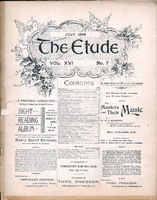BY E. M. TREVENEN DAWSON.
What I want to know is why so many writers of instruction books, or books on musical theory, either snub those four unfortunate keys, or ignore them altogether.
It is hardly necessary to say that I refer to C-sharp and C-flat majors and their relative minors, the omission of which in scale manuals, tutors, and elementary (or advanced, for the matter of that) theoretical text-books must often have struck the thoughtful teacher. Then, where not absolutely ignored, they are generally mentioned slightingly, as “identical with the scales of D-flat and B majors, B-flat and G sharp minors, and, therefore, unnecessary to be learned separately,” or “to be printed in full,” or “and the fingering is the same.” In fact, even F-sharp major and its relative minor are sometimes treated in the same slighting fashion, being merely named as “identical with G-flat major and E-flat minor,” or vice versa. And only to think of the long list that might be compiled of works in these keys, by Chopin and Liszt, say, alone! As to the four most neglected keys, however, I have seen it deliberately stated in a pianoforte “Instructor” that “it is not necessary to learn scales with seven sharps or seven flats, as no music is ever written in these keys” (or some such words; I quote from memory). Shades of Bach and Beethooven! what an assertion! Just think of the former’s fine C sharp major Prelude and Fugue, and the latter’s magnificent A flat minor “Marcia funebre sulla morte d’un eroe,” in Op. 26! If there existed but these two immortal compositions in those poor, despised keys, would it not be worth while to learn them, not to mention Beethoven’s Waltz No. 7, “Jubel Walzer” in C-sharp major?
But it is by no means instruction books alone which sin against the “four neglected keys.” As mentioned above, theoretical books on the elements and on harmony frequently omit them. How often has one not seen the “Circle of 5ths” in English, the “Quintenzirkel” in German ones, name the keys only up to G-flat (or F-sharp) with “F-sharp” (or “G-flat”) in parenthesis beside it! Very rarely is “C-sharp to be seen within brackets beside D-flat, while poor C-flat is even worse treated and seldom allowed to put in an appearance. Or, again, if a table of tonic chords, or, say, dominant 7ths is given, the set ends almost invariably with those in keys of six sharps or flats only.
Now why is this? What have the poor things done to be so neglected?
“They are not used by composers.” That can hardly be said; for, although few entire compositions have them for principal key, yet often a movement, a section, a period, a modulating passage, gives them prominence for a certain number of bars. And if only occasionally this occurs, still that student is at a decided disadvantage who has never practiced or even heard of them.
“They are identical with D-flat and B, and their relative minors.” Well, on the pianoforte I grant you, so they are. Their sound is the same, their fingering is the same, the same succession of black and white keys is made use of. (On stringed instruments, be it remembered, the fingering does differ for enharmonically changed keys). But—and this I consider a very important point—the notation is totally different, and thus many a pupil who would boldly place the thumb on f and c in D-flat major, hesitates to do the same on e-sharp and b-sharp in C-sharp minor, or who would read b and e with instant certainty in the key of B, is brought to a dead stop by C-flat and F-flat in the key of C-flat.
Fluency and ability to read in any key should certainly be aimed at by all pianists; therefore, these four neglected scales need practicing as much as any, if not more, seeing that they are more difficult. That is to say, they are more difficult to grasp mentally—not physically—whether by pianists or vocalists; for a very distinguished singing master once said in my hearing that whereas any vocalist would sing the interval a-b (say) with ease, if called upon immediately afterward to sing a C-flat, he was almost certain to sing it wrong or with very uncertain intonation.
Again, when modulations—or even merely transitions into one or other of these keys—appear in the course of a composition, it is of importance that the student should be able still to “keep his feet” and to play or name, as the case may be, such chords and chord progressions as unhesitatingly as those in any other part of the work.
For these reasons, therefore, I strongly deprecate the neglect of C-sharp and C-flat majors, A-sharp and A-flat minors, and should like to see them noticed in every tutor and musico-theoretical work, printed out in full in every scale manual, and taught to all but to the very youngest pupils.



